![]()
![]()
![]()
Use LEFT and RIGHT arrow keys to navigate between flashcards;
Use UP and DOWN arrow keys to flip the card;
H to show hint;
A reads text to speech;
22 Cards in this Set
- Front
- Back
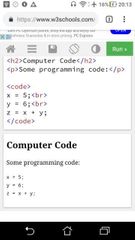
|
E |
|
|
<kbd> element |

represents user input, like keyboard input or voice commands. ## Text surrounded by <kbd> tags typ displayed browser's default monospace font
ex.<p>Save the document by pressing <kbd>Ctrl + S</kbd></p> |
|
|
<samp> element |

represents output from program or computing system. ##Text surrounded <samp> typ displayed browser's default monospace font ex. <p>If you input wrong value, the program will return <samp>Error!</samp></p> |
|
|
<code> element |
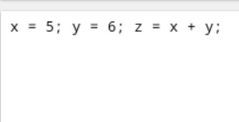
defines a fragment of computer code. ## text in <code> displayed moonscape font ex. <code> x = 5; y = 6; z = x + y; </code>
## can keep preformatted form w/ <pre> |
|
|
<var> element |

defines a variable (math or programming context) ex. <p>Einstein wrote: <var>E</var> = <var>mc</var><sup>2</sup>.</p> |
|
|
Define the text "var person;" as programming code. |
<code>var person</code> |
|
|
Define character "x" as a variable. |
<var>x</var> |
|
|
HTML Entities |
&entity_name; OR &#entity_number; = displays reserved characters ex. use < & > in text, browser may conf w/ tags ex. less than (<) sign = '&It;' or '<' ##Browsers may not support all entity names, but the support for numbers is good. ## Entity name case-sensitive |
|
|
' ' OR ' ' character entity |
A non-breaking space ## 2 words seperated by nbsp won't break new line (ex. handy w/ 10 km/h, 10 PM) ## also can prevent browsers truncating spaces in HTML pages. |
|
|
"‑" character entity |
The non-breaking hyphen ## hyphen character (‑) that won't break. |
|
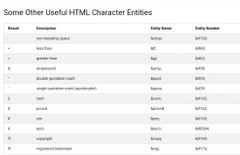
|
E |
|
|
diacritical mark |

a "glyph" added to a letter. ex. accents grave( ̀) & acute( ́) ## can appear above, below, inside letter, & b/w 2 letters. |
|
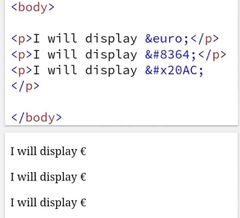
|
E |
|
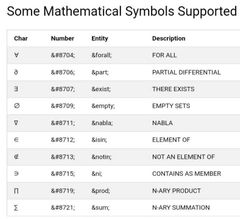
https://www.w3schools.com/charsets/ref_utf_math.asp |
E |
|
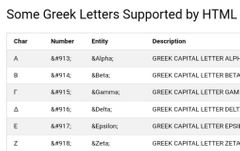
https://www.w3schools.com/charsets/ref_utf_greek.asp |
E |
|
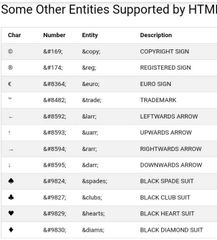
https://www.w3schools.com/charsets/ref_utf_currency.asp https://www.w3schools.com/charsets/ref_utf_arrows.asp https://www.w3schools.com/charsets/ref_utf_symbols.asp |
E |
|
|
How to display character set? |
<meta charset="UTF-8"> w/ charset attrib in meta tag ## HTML4: <meta http-equiv="Content-Type" content="text/html;charset=ISO-8859-1"> ### If browser detects ISO-8859-1 in web page, defaults to ANSI. |
|
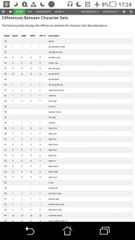
|
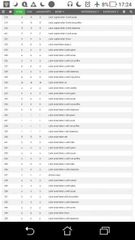
|
|
|
ASCII Character Set |
defines 128 different alphanumeric (#s 0-9, EngLetters A-Z & some special characters like ! $ + - ( ) @ < >) ## 1st character encoding standard (also called character set). (i) 0 to 31 (and 127) = control characters (ii) 32 to 126 = letters, digits & symbols. ## doesn't use 128 to 255.
|
|
|
ANSI Character Set (Windows-1252) |
original Windows character set ## identical ISO-8859-1, except has 32 extra characters.
(i) 0 to 127 = control characters, identical to ASCII (ii) 128 to 159 = proprietary set characters (iii) 160 to 255 = identical to UTF-8 |
|
|
ISO-8859-1 Character Set |
default character set HTML 4 ## supports 256 diff character codes. (i) 0 to 127 = identical to ASCII (ii) 128 to 159 = doesn't use (iii) 160 to 255 = identical to UTF-8 |
|
|
UTF-8 Character Set |
default character encoding HTML5 ## covers almost all of the characters and symbols in the world (i) 0 to 127 = identical to ASCII (ii) 128 to 159= d/ use (iii) 160 to 255 = identical both ANSI & 8859-1 (iv) continues from 256 w/ >10 000 diff characters. |

